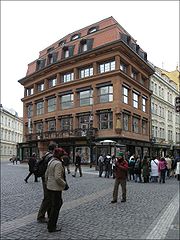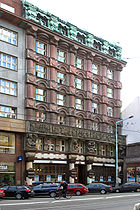
Czech Cubism
Encyclopedia


Avant-garde
Avant-garde means "advance guard" or "vanguard". The adjective form is used in English to refer to people or works that are experimental or innovative, particularly with respect to art, culture, and politics....
art movement of Czech proponents of Cubism
Cubism
Cubism was a 20th century avant-garde art movement, pioneered by Pablo Picasso and Georges Braque, that revolutionized European painting and sculpture, and inspired related movements in music, literature and architecture...
, active mostly in Prague
Prague
Prague is the capital and largest city of the Czech Republic. Situated in the north-west of the country on the Vltava river, the city is home to about 1.3 million people, while its metropolitan area is estimated to have a population of over 2.3 million...
from 1910 to 1914.
Members of this movement realised the epochal significance of the Cubism of Pablo Picasso
Pablo Picasso
Pablo Diego José Francisco de Paula Juan Nepomuceno María de los Remedios Cipriano de la Santísima Trinidad Ruiz y Picasso known as Pablo Ruiz Picasso was a Spanish expatriate painter, sculptor, printmaker, ceramicist, and stage designer, one of the greatest and most influential artists of the...
and Georges Braque
Georges Braque
Georges Braque[p] was a major 20th century French painter and sculptor who, along with Pablo Picasso, developed the art style known as Cubism.-Early Life:...
and attempted to extract its components for their own work in all branches of artistic creativity - sculpture
Sculpture
Sculpture is three-dimensional artwork created by shaping or combining hard materials—typically stone such as marble—or metal, glass, or wood. Softer materials can also be used, such as clay, textiles, plastics, polymers and softer metals...
, painting
Painting
Painting is the practice of applying paint, pigment, color or other medium to a surface . The application of the medium is commonly applied to the base with a brush but other objects can be used. In art, the term painting describes both the act and the result of the action. However, painting is...
, applied arts and architecture
Architecture
Architecture is both the process and product of planning, designing and construction. Architectural works, in the material form of buildings, are often perceived as cultural and political symbols and as works of art...
. The Czech Otto Gutfreund
Otto Gutfreund
Otto Gutfreund was a Czech-Czechoslovak cubist sculptor. He is acknowledged by the art historian Douglas Cooper to be the author of the first cubist sculpture: Anxiety , created in 1911 and exhibited in Paris in 1912.- Life :...
is acknowledged, by the art critic Douglas Cooper (1911-1984), to be the author of the first Cubist sculpture
Cubist sculpture
Cubist sculpture is a style developed in parallel with cubist painting, centered in Paris, beginning around 1909 and evolving through the early 1920s.The style is most closely associated with the formal experiments of Georges Braque and Pablo Picasso...
Anxiety (Úzkost in Czech), created in 1911 and exhibited in Paris in 1912.
The most notable participants in this movement were the painters Emil Filla
Emil Filla
Emil Filla , a Czech painter, was a leader of the Avant-Garde in Prague between World War I and World War II and was an early Cubist painter....
, Bohumil Kubišta
Bohumil Kubista
Bohumil Kubišta was a Czech painter and art critic, one of the founders of Czech modern painting. He studied at the School of Applied Arts in Prague, but left in 1906 to study at the Reale Istituto di Belle Arti in Florence...
, Antonín Procházka, and Josef Čapek
Josef Capek
Josef Čapek was a Czech artist who was best known as a painter, but who was also noted as a writer and a poet. He invented the word robot, which was introduced into literature by his brother, Karel Čapek.- Biography :...
, the sculptor Otto Gutfreund
Otto Gutfreund
Otto Gutfreund was a Czech-Czechoslovak cubist sculptor. He is acknowledged by the art historian Douglas Cooper to be the author of the first cubist sculpture: Anxiety , created in 1911 and exhibited in Paris in 1912.- Life :...
, the writer Karel Čapek
Karel Capek
Karel Čapek was Czech writer of the 20th century.-Biography:Born in 1890 in the Bohemian mountain village of Malé Svatoňovice to an overbearing, emotional mother and a distant yet adored father, Čapek was the youngest of three siblings...
, and the architects Pavel Janák
Pavel Janák
Pavel Janák was a Czech modernist architect, furniture designer, town planner, professor and theoretician.Janák studied with Otto Wagner in Vienna between 1906 and 1908, and worked in Prague under Jan Kotěra...
, Josef Gočár
Josef Gocár
Josef Gočár , was a Czech architect, one of the founders of modern architecture in Czechoslovakia....
, Vlastislav Hofman
Vlastislav Hofman
Vlastislav Hofman was a Czech artist and architect. Though he was a painter, set designer, graphic artist, furniture designer, and author, Hofman is best known as an architect strongly influenced by Cubism....
and Josef Chochol
Josef Chochol
Josef Chochol was a Czech architect.-Education:Chocol studied architecture at the polytechnic in Prague , then at the academy in Vienna, under guidance of Otto Wagner .-Career:...
. Many of these artists were members of the Mánes Union of Fine Arts
Mánes Union of Fine Arts
The Manes Association of Fine Artists was an artists' association and exhibition society founded in 1887 in Prague and named after the painter Josef Mánes....
. A major division in Czech architecture occurred in 1911 when many young avant-garde artists from Jan Kotĕra
Jan Kotera
Jan Kotěra was a Czech architect, artist and interior designer, and one of the key figures of modern architecture in Bohemia.-Biography:...
and his circle divorced themselves from the Mánes Association. These younger architects were more idealistic in their outlook and criticized the strict rationalism of their forebears, Otto Wagner
Otto Wagner
Otto Koloman Wagner was an Austrian architect and urban planner, known for his lasting impact on the appearance of his home town Vienna, to which he contributed many landmarks.-Life:...
and Kotĕra. Janák, Gočár, and Hofman founded the group Skupina výtvarných umĕlců (Group of Plastic Artists) and established a journal for the group, Umĕlecký mĕsíčník (Artistic Monthly).
After Czechoslovakia
Czechoslovakia
Czechoslovakia or Czecho-Slovakia was a sovereign state in Central Europe which existed from October 1918, when it declared its independence from the Austro-Hungarian Empire, until 1992...
's founding in 1918, architectural Czech Cubism gradually developed into Czech Rondocubism, which was more decorative, as it was influenced by traditional folk ornaments to celebrate the revival of Czech national independence.
The Concept
Czech Cubists distinguish their work through the construction of sharp points, slicing planes, and crystalline shapes in their art works. These angles allowed the Czech Cubists to incorporate their own trademark in the avant-garde art group of ModernismModernism
Modernism, in its broadest definition, is modern thought, character, or practice. More specifically, the term describes the modernist movement, its set of cultural tendencies and array of associated cultural movements, originally arising from wide-scale and far-reaching changes to Western society...
. They believed that objects carried their own inter energy which could only be released by splitting the horizontal and vertical surfaces that restrain the conservative design and “ignore the needs of the human soul.” It was a way to revolt from the typical art scene in the early 1900s in Europe. This evolved into a new art movement
Art movement
An art movement is a tendency or style in art with a specific common philosophy or goal, followed by a group of artists during a restricted period of time, or, at least, with the heyday of the movement defined within a number of years...
. Pyramid and crystal forms were one of the signature principles seen in Czech Cubism which was incorporated in architecture, furniture, and applied arts.
The History
The first signs of Czech cubism came to be in the 1910s. It was a contemporary development of functionalism generated by architects and designers in Prague. Fifteen years prior, the first concept of cubism itself was written off as a decorative purpose, a replacement of secessionism and mistaken departure into ‘aesthetictism’ and ‘individualism’. On the contrary, it was a revolt against traditional values of realismRealism
Realism, Realist or Realistic are terms that describe any manifestation of philosophical realism, the belief that reality exists independently of observers, whether in philosophy itself or in the applied arts and sciences. In this broad sense it is frequently contrasted with Idealism.Realism in the...
.
Czech cubism was first conceal by the Modern Movement and masked by the aesthetic dictates of Stalinist and post-Stalinist culture in Czechoslovakia. After the Velvet Revolution of 1989 and the post modern attraction of ornamentation and decoration, there came to be a rise of fascination in Czech culture and its own unique forms of cubism. Czech cubism developed paradoxically as both a product of Czech bourgeois affluence and as an avant-garde rejection of secessionist designers such as Otto Wagner and Jan Kotera. Architects such as Josef Chochol and Pavel Janak devised spiritualist philosophies of design and a dynamic ideal of planar form derived from cubist art. As Cubism spread across the European continent in the early 20th century, its greatest impact can be seen today in the Czech Republic.

